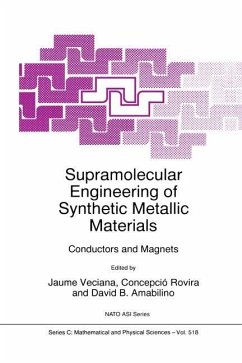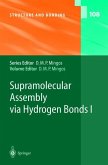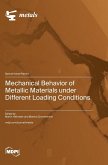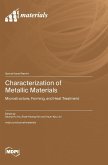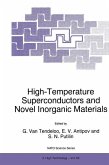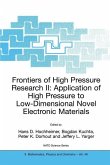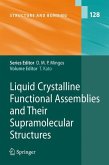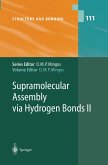VecianaConductors and Magnets
Supramolecular Engineering of Synthetic Metallic Materials
Conductors and Magnets
Herausgegeben:Veciana, Jaume; Rovira, Concepció; Amabillino, David Brian
VecianaConductors and Magnets
Supramolecular Engineering of Synthetic Metallic Materials
Conductors and Magnets
Herausgegeben:Veciana, Jaume; Rovira, Concepció; Amabillino, David Brian
- Gebundenes Buch
- Merkliste
- Auf die Merkliste
- Bewerten Bewerten
- Teilen
- Produkt teilen
- Produkterinnerung
- Produkterinnerung
The creation of molecular materials that have desired electrical conductance and magnetic properties demands the precise arrangement of molecules in the solid state. Such controlled arrangement has been achieved very elegantly by supramolecular chemists, especially those practising crystal engineering. This book, which presents articles by foremost experts in crystal engineering, molecular conductors and magnetic magnetism, reveals the results of an interdisciplinary union that may well have a profound influence on the future of materials science. Theoretical studies reveal potential areas of…mehr
Andere Kunden interessierten sich auch für
![Supramolecular Assembly via Hydrogen Bonds I Supramolecular Assembly via Hydrogen Bonds I]() Supramolecular Assembly via Hydrogen Bonds I153,99 €
Supramolecular Assembly via Hydrogen Bonds I153,99 €![Mechanical Behavior of Metallic Materials under Different Loading Conditions Mechanical Behavior of Metallic Materials under Different Loading Conditions]() Mechanical Behavior of Metallic Materials under Different Loading Conditions93,99 €
Mechanical Behavior of Metallic Materials under Different Loading Conditions93,99 €![Characterization of Metallic Materials Characterization of Metallic Materials]() Characterization of Metallic Materials84,99 €
Characterization of Metallic Materials84,99 €![High-Temperature Superconductors and Novel Inorganic Materials High-Temperature Superconductors and Novel Inorganic Materials]() Van TendelooHigh-Temperature Superconductors and Novel Inorganic Materials153,99 €
Van TendelooHigh-Temperature Superconductors and Novel Inorganic Materials153,99 €![Frontiers of High Pressure Research II: Application of High Pressure to Low-Dimensional Novel Electronic Materials Frontiers of High Pressure Research II: Application of High Pressure to Low-Dimensional Novel Electronic Materials]() HochheimerFrontiers of High Pressure Research II: Application of High Pressure to Low-Dimensional Novel Electronic Materials116,99 €
HochheimerFrontiers of High Pressure Research II: Application of High Pressure to Low-Dimensional Novel Electronic Materials116,99 €![Liquid Crystalline Functional Assemblies and Their Supramolecular Structures Liquid Crystalline Functional Assemblies and Their Supramolecular Structures]() Liquid Crystalline Functional Assemblies and Their Supramolecular Structures226,99 €
Liquid Crystalline Functional Assemblies and Their Supramolecular Structures226,99 €![Supramolecular Assembly via Hydrogen Bonds II Supramolecular Assembly via Hydrogen Bonds II]() Supramolecular Assembly via Hydrogen Bonds II153,99 €
Supramolecular Assembly via Hydrogen Bonds II153,99 €-
-
-
The creation of molecular materials that have desired electrical conductance and magnetic properties demands the precise arrangement of molecules in the solid state. Such controlled arrangement has been achieved very elegantly by supramolecular chemists, especially those practising crystal engineering.
This book, which presents articles by foremost experts in crystal engineering, molecular conductors and magnetic magnetism, reveals the results of an interdisciplinary union that may well have a profound influence on the future of materials science. Theoretical studies reveal potential areas of interest for those investigating molecular conductors and magnets, as well as materials that exhibit both properties.
A unique survey of the state of the art appealing to all those doing research in supramolecular chemistry and materials science.
This book, which presents articles by foremost experts in crystal engineering, molecular conductors and magnetic magnetism, reveals the results of an interdisciplinary union that may well have a profound influence on the future of materials science. Theoretical studies reveal potential areas of interest for those investigating molecular conductors and magnets, as well as materials that exhibit both properties.
A unique survey of the state of the art appealing to all those doing research in supramolecular chemistry and materials science.
Produktdetails
- Produktdetails
- Nato Science Series C: 518
- Verlag: Springer / Springer Netherlands
- Artikelnr. des Verlages: 978-0-7923-5311-9
- 1998.
- Seitenzahl: 516
- Erscheinungstermin: 31. Oktober 1998
- Englisch
- Abmessung: 241mm x 160mm x 36mm
- Gewicht: 1024g
- ISBN-13: 9780792353119
- ISBN-10: 0792353110
- Artikelnr.: 23115272
- Herstellerkennzeichnung
- Springer-Verlag GmbH
- Tiergartenstr. 17
- 69121 Heidelberg
- ProductSafety@springernature.com
- Nato Science Series C: 518
- Verlag: Springer / Springer Netherlands
- Artikelnr. des Verlages: 978-0-7923-5311-9
- 1998.
- Seitenzahl: 516
- Erscheinungstermin: 31. Oktober 1998
- Englisch
- Abmessung: 241mm x 160mm x 36mm
- Gewicht: 1024g
- ISBN-13: 9780792353119
- ISBN-10: 0792353110
- Artikelnr.: 23115272
- Herstellerkennzeichnung
- Springer-Verlag GmbH
- Tiergartenstr. 17
- 69121 Heidelberg
- ProductSafety@springernature.com
Some Current Challenges in Crystal Engineering.- Structural and Crystallographic Aspects of Supramolecular Engineering Structure-Property Relations Polymorphism and Crystal Growth.- The Computer Prediction of the Assembling of Organic Molecules into Crystals: A Perspective.- Molecular Networks: An Approach to Coordination Polymers.- The Prediction and Production of Polar Molecular Materials: From Markov's Theory to Crystal Growth.- NMR Spectroscopy and the Development of Structural Models for Crystalline Supramolecular Solids - Applications to p-tert-butylcalix[4]arenes.- Crystal Engineering of Purely Organic Molecular Magnets: What can ab initio Computations Tell us?.- Hysteresis and Memory Effect in Supramolecular Chemistry.- Tunable Nitroxide Free Radical Ligands: From Zero-to Two-Dimensional Metal-Radical Networks.- Examples of Supramolecular Coordination Compounds and their Supramolecular Functions.- Manganoporphyrin TCNE Electron Transfer Complexes - Structure-Function Correlations.- Dithiadiazolyl Radicals as Molecular Bricks for High TcOrganic Magnets.- Host-Guest Interactions for Tuning the Magnetic Coupling in Metal Ion Clusters.- Exotic Crystal Structures and Magnetic Properties of Nitronylnitroxide Cation Radical Salts. Collapse of Spin-Gap Ground State in Distorted Antiferromagnetic Kagome Lattices.- Conductivity, Chirality and Conductivity in Layer Molecular Magnets.- Molecular Conductors and Magnets: Structure-Property Relationships.- Hybrid Materials Formed by Two Molecular Networks. Magnetic Conductors, Magnetic Multilayers and Magnetic Films.- Interplay of Conductivity and Magnetism in BETS-Derived Compounds (BETS = bis(ethylenedithio)tetraselenafulvalene).- The Flexibility of Molecular Components as a Tool in the Construction of Conducting andMagnetic Systems.- Hydrogen Bonding and Transport Properties of Molecular Conductors.- Insight into the Behavior of M(TCNQ)n(n = 1,2) Crystalline Solids and Films: X-Ray Magnetic and Conducting Properties.- Tetrathiafulvalene (TTF) Derivatives as Versatile Building Blocks: From Metals to Spin Ladders.- Novel Hyper Electron-Accepting Molecules for Development of Organic Materials.- Low-Dimensional Organic Superconductors ?-(BEDT-TTF)2Cu[N(CN)2]X, where X = Br0.5Cl0.5Br0.7Cl0.3and Br0.9I0.1.- Tetrathiafulvalenes: Building Blocks in Macrocyclic and Supramolecular Chemistry.- A New Range of Functionalised Tetrathiafulvalenes and their Cation Radical Salts: Synthetic and Solid State Studies.- New Tetrathiafulvalenes for Advanced Materials.- Metal Phosphonate Langmuir-Blodgett Films: Magnetic Monolayers and Organic/Inorganic Dual Network Assemblies.- Supramolecular Engineering of Conducting Thin Films by Covalently Hinging Electroactive Molecular Surfactants.
Some Current Challenges in Crystal Engineering.- Structural and Crystallographic Aspects of Supramolecular Engineering Structure-Property Relations Polymorphism and Crystal Growth.- The Computer Prediction of the Assembling of Organic Molecules into Crystals: A Perspective.- Molecular Networks: An Approach to Coordination Polymers.- The Prediction and Production of Polar Molecular Materials: From Markov's Theory to Crystal Growth.- NMR Spectroscopy and the Development of Structural Models for Crystalline Supramolecular Solids - Applications to p-tert-butylcalix[4]arenes.- Crystal Engineering of Purely Organic Molecular Magnets: What can ab initio Computations Tell us?.- Hysteresis and Memory Effect in Supramolecular Chemistry.- Tunable Nitroxide Free Radical Ligands: From Zero-to Two-Dimensional Metal-Radical Networks.- Examples of Supramolecular Coordination Compounds and their Supramolecular Functions.- Manganoporphyrin TCNE Electron Transfer Complexes - Structure-Function Correlations.- Dithiadiazolyl Radicals as Molecular Bricks for High TcOrganic Magnets.- Host-Guest Interactions for Tuning the Magnetic Coupling in Metal Ion Clusters.- Exotic Crystal Structures and Magnetic Properties of Nitronylnitroxide Cation Radical Salts. Collapse of Spin-Gap Ground State in Distorted Antiferromagnetic Kagome Lattices.- Conductivity, Chirality and Conductivity in Layer Molecular Magnets.- Molecular Conductors and Magnets: Structure-Property Relationships.- Hybrid Materials Formed by Two Molecular Networks. Magnetic Conductors, Magnetic Multilayers and Magnetic Films.- Interplay of Conductivity and Magnetism in BETS-Derived Compounds (BETS = bis(ethylenedithio)tetraselenafulvalene).- The Flexibility of Molecular Components as a Tool in the Construction of Conducting andMagnetic Systems.- Hydrogen Bonding and Transport Properties of Molecular Conductors.- Insight into the Behavior of M(TCNQ)n(n = 1,2) Crystalline Solids and Films: X-Ray Magnetic and Conducting Properties.- Tetrathiafulvalene (TTF) Derivatives as Versatile Building Blocks: From Metals to Spin Ladders.- Novel Hyper Electron-Accepting Molecules for Development of Organic Materials.- Low-Dimensional Organic Superconductors ?-(BEDT-TTF)2Cu[N(CN)2]X, where X = Br0.5Cl0.5Br0.7Cl0.3and Br0.9I0.1.- Tetrathiafulvalenes: Building Blocks in Macrocyclic and Supramolecular Chemistry.- A New Range of Functionalised Tetrathiafulvalenes and their Cation Radical Salts: Synthetic and Solid State Studies.- New Tetrathiafulvalenes for Advanced Materials.- Metal Phosphonate Langmuir-Blodgett Films: Magnetic Monolayers and Organic/Inorganic Dual Network Assemblies.- Supramolecular Engineering of Conducting Thin Films by Covalently Hinging Electroactive Molecular Surfactants.

